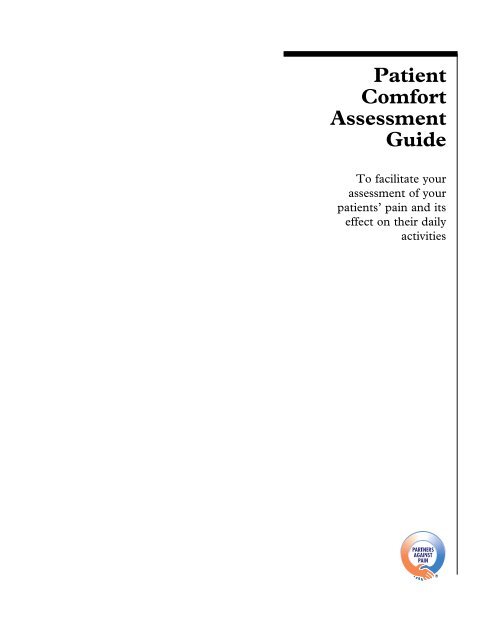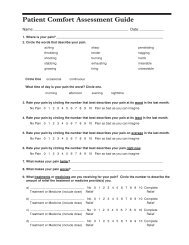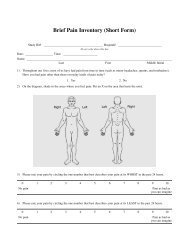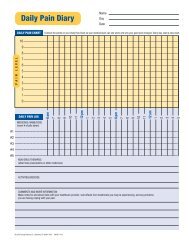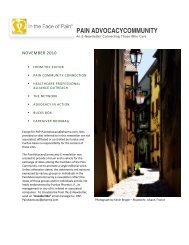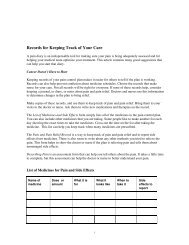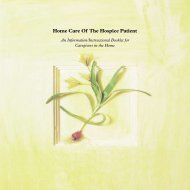Patient Comfort Assessment Guide - Partners Against Pain
Patient Comfort Assessment Guide - Partners Against Pain
Patient Comfort Assessment Guide - Partners Against Pain
You also want an ePaper? Increase the reach of your titles
YUMPU automatically turns print PDFs into web optimized ePapers that Google loves.
<strong>Patient</strong><br />
<strong>Comfort</strong><br />
<strong>Assessment</strong><br />
<strong>Guide</strong><br />
To facilitate your<br />
assessment of your<br />
patients’ pain and its<br />
effect on their daily<br />
activities<br />
®
<strong>Patient</strong> <strong>Comfort</strong> <strong>Assessment</strong> <strong>Guide</strong><br />
Pharmacologic management of pain, as a component of<br />
the total management of the patient with persistent pain, is<br />
increasingly utilized among healthcare professionals.<br />
Although healthcare professionals want to provide optimal<br />
care for their patients, time constraints often impose barriers<br />
that may interfere with the goals of care. Applying pharmacologic<br />
protocols for pain management requires proper<br />
evaluation, implementation, and monitoring.<br />
To assist in this challenge, Purdue has supported the<br />
development of a concise documentation tool to help the<br />
clinician with the assessment of pain and implementation<br />
of pain treatment regimens. This PATIENT COMFORT<br />
ASSESSMENT GUIDE encompasses pain status, pain relief,<br />
other symptoms and side effects, as well as the impact of<br />
pain on the patient’s functional status. For clinical purposes,<br />
these components have proven helpful in monitoring<br />
and documenting the status of patients and their response<br />
to treatment interventions.<br />
This guide was prepared by the late Elizabeth J. Narcessian,<br />
MD, clinical chief of pain management at the Kessler<br />
Institute for Rehabilitation. Her deep concern for patient<br />
comfort led Dr. Narcessian to compile this assessment<br />
guide from components of other survey instruments that<br />
have been developed and validated in their entirety.<br />
In her introduction to the first edition, Dr. Narcessian<br />
observed: “As we strive to optimize the quality of life of our<br />
patients by decreasing their pain, it is imperative that we<br />
maintain proper documentation both to monitor effectiveness<br />
of the treatment protocol, as well as provide data to<br />
track the patient’s status. This task can be simplified by<br />
using the PATIENT COMFORT ASSESSMENT GUIDE.”<br />
®
<strong>Patient</strong> <strong>Comfort</strong> <strong>Assessment</strong> <strong>Guide</strong><br />
Name: ––––––––––––––––––––––––––––––––––––––––––––––––––– Date: –––––––––––––<br />
1. Where is your pain? _____________________________________________________________________<br />
2. Circle the words that describe your pain.<br />
aching sharp penetrating<br />
throbbing tender nagging<br />
shooting burning numb<br />
stabbing exhausting miserable<br />
gnawing tiring unbearable<br />
Circle One occasional continuous<br />
What time of day is your pain the worst? Circle one.<br />
morning afternoon evening nighttime<br />
3. Rate your pain by circling the number that best describes your pain at its worst in the last month.<br />
No <strong>Pain</strong> 0 1 2 3 4 5 6 7 8 9 10 <strong>Pain</strong> as bad as you can imagine<br />
4. Rate your pain by circling the number that best describes your pain at its least in the last month.<br />
No <strong>Pain</strong> 0 1 2 3 4 5 6 7 8 9 10 <strong>Pain</strong> as bad as you can imagine<br />
5. Rate your pain by circling the number that best describes your pain on average in the last month.<br />
No <strong>Pain</strong> 0 1 2 3 4 5 6 7 8 9 10 <strong>Pain</strong> as bad as you can imagine<br />
6. Rate your pain by circling the number that best describes your pain right now.<br />
No <strong>Pain</strong> 0 1 2 3 4 5 6 7 8 9 10 <strong>Pain</strong> as bad as you can imagine<br />
7. What makes your pain better? ––––––––––––––––––––––––––––––––––––––––––––––––––––––––––––<br />
8. What makes your pain worse? –––––––––––––––––––––––––––––––––––––––––––––––––––––––––––<br />
9. What treatments or medicines are you receiving for your pain? Circle the number to describe the<br />
amount of relief the treatment or medicine provide(s) you.<br />
a) ––––––––––––––––––––––––––––––––––– No 0 1 2 3 4 5 6 7 8 9 10 Complete<br />
Treatment or Medicine (include dose) Relief Relief<br />
b) ––––––––––––––––––––––––––––––––––– No 0 1 2 3 4 5 6 7 8 9 10 Complete<br />
Treatment or Medicine (include dose) Relief Relief<br />
c) –––––––––––––––––––––––––––––––––––– No 0 1 2 3 4 5 6 7 8 9 10 Complete<br />
Treatment or Medicine (include dose) Relief Relief<br />
d) ––––––––––––––––––––––––––––––––––– No 0 1 2 3 4 5 6 7 8 9 10 Complete<br />
Treatment or Medicine (include dose) Relief Relief
10. What side effects or symptoms are you having? Circle the number that best describes your<br />
experience during the past week.<br />
a. Nausea Barely 0 1 2 3 4 5 6 7 8 9 10 Severe Enough<br />
Noticeable to Stop Medicine<br />
b. Vomiting Barely 0 1 2 3 4 5 6 7 8 9 10 Severe Enough<br />
Noticeable to Stop Medicine<br />
c. Constipation Barely 0 1 2 3 4 5 6 7 8 9 10 Severe Enough<br />
Noticeable to Stop Medicine<br />
d. Lack of Appetite Barely 0 1 2 3 4 5 6 7 8 9 10 Severe Enough<br />
Noticeable to Stop Medicine<br />
e. Tired Barely 0 1 2 3 4 5 6 7 8 9 10 Severe Enough<br />
Noticeable to Stop Medicine<br />
f. Itching Barely 0 1 2 3 4 5 6 7 8 9 10 Severe Enough<br />
Noticeable to Stop Medicine<br />
g. Nightmares Barely 0 1 2 3 4 5 6 7 8 9 10 Severe Enough<br />
Noticeable to Stop Medicine<br />
h. Sweating Barely 0 1 2 3 4 5 6 7 8 9 10 Severe Enough<br />
Noticeable to Stop Medicine<br />
i. Difficulty Thinking Barely 0 1 2 3 4 5 6 7 8 9 10 Severe Enough<br />
Noticeable to Stop Medicine<br />
j. Insomnia Barely 0 1 2 3 4 5 6 7 8 9 10 Severe Enough<br />
Noticeable to Stop Medicine<br />
11. Circle the one number that describes how during the past week pain has interfered with your:<br />
a. General Activity Does Not 0 1 2 3 4 5 6 7 8 9 10 Completely<br />
Interfere Interferes<br />
b. Mood Does Not 0 1 2 3 4 5 6 7 8 9 10 Completely<br />
Interfere Interferes<br />
c. Normal Work Does Not 0 1 2 3 4 5 6 7 8 9 10 Completely<br />
Interfere Interferes<br />
d. Sleep Does Not 0 1 2 3 4 5 6 7 8 9 10 Completely<br />
Interfere Interferes<br />
e. Enjoyment of Life Does Not 0 1 2 3 4 5 6 7 8 9 10 Completely<br />
Interfere Interferes<br />
f. Ability to Concentrate Does Not 0 1 2 3 4 5 6 7 8 9 10 Completely<br />
Interfere Interferes<br />
g. Relations with Does Not 0 1 2 3 4 5 6 7 8 9 10 Completely<br />
Other People Interfere Interferes<br />
Prepared by Elizabeth J. Narcessian, MD, Clinical Chief of <strong>Pain</strong> Management, Kessler Institute for Rehabilitation, Inc. G5375 PAP023 11/11<br />
®
<strong>Partners</strong> <strong>Against</strong> <strong>Pain</strong> ®<br />
is a service brought to you by<br />
Purdue Pharma L.P.<br />
Sources: Brief <strong>Pain</strong> Inventory, Charles Cleeland, Copyright 1991. McCorkle R, Young K. Development of a symptom distress scale. Cancer Nursing. 1978;1:373-378.<br />
© 2004, 2011 Purdue Pharma L.P., Stamford, CT 06901 G5375 PAP023 11/11


